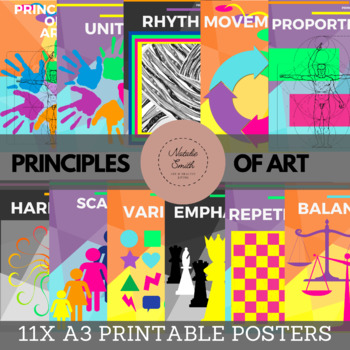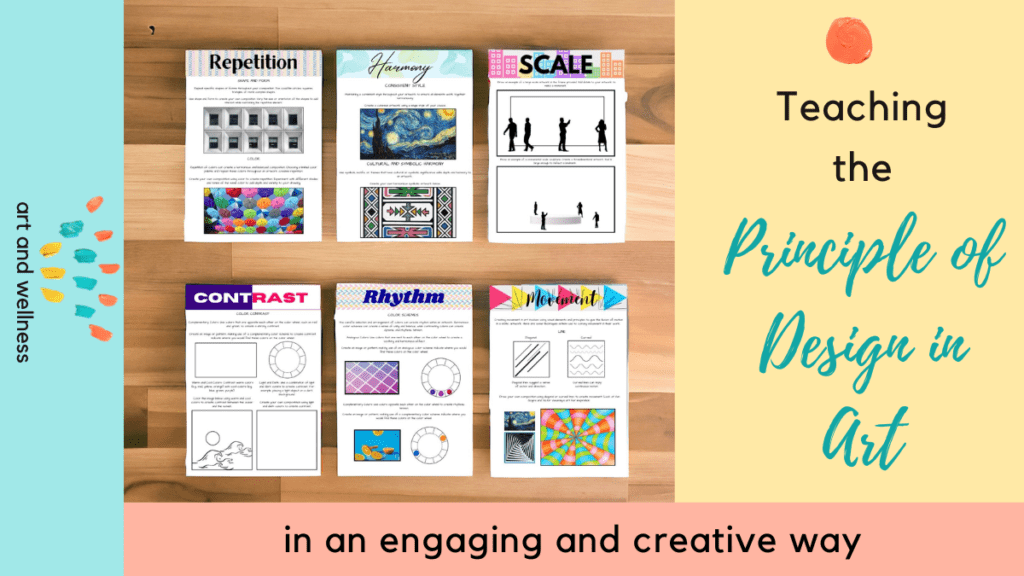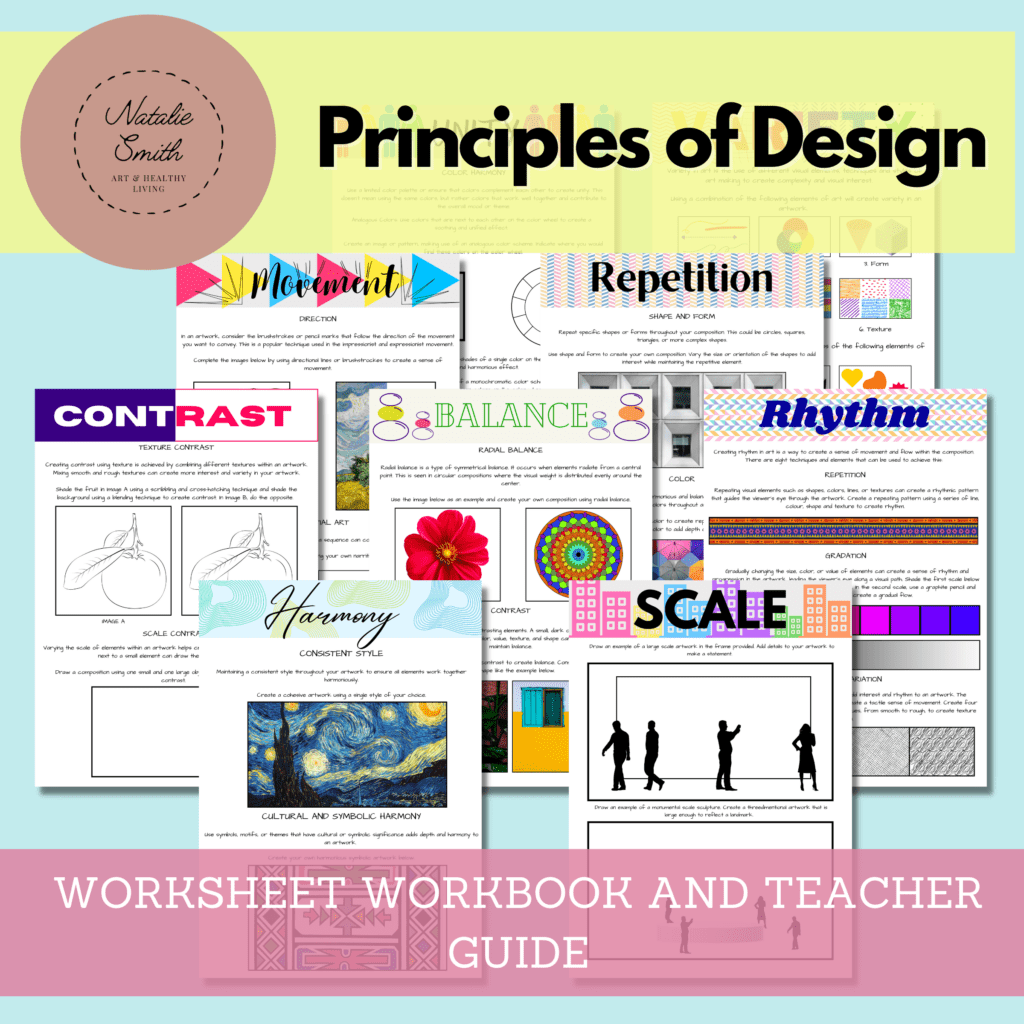Teaching the principle of designs in art is not just about teaching techniques; it’s about fostering creativity, expression, and understanding the principles that underpin great art. One such crucial aspect is the principles of design. From balance in art to Creating colour harmony, these principles are the building blocks of visual composition, guiding artists to create harmonious and impactful works. However, teaching these principles can sometimes be challenging. In this blog post, we’ll explore engaging and creative ways to teach the principles of design in art, making the learning process both enjoyable and effective.
Start with the Basics
Before delving into the complexities of the principle of designs in art, it’s important to establish a solid foundation. Introduce students to the basic elements of art such as line, form, shape, colour, texture, and space. Through hands-on activities and exploration, students can understand how these elements interact to form the building blocks of art composition.
Visual Examples and Analysis
Bring art into the classroom! Show students a diverse range of artworks that showcase each design principle. It is a wonderful opportunity to introduce classic masterpieces and contemporary local pieces, encourage students to analyze how these principles are applied in different contexts. Discussing artworks not only enhances visual literacy but also sparks critical thinking and creativity.
Adding posters to the classroom can be a helpful reminder to the student of the principle of designs in art. Check out these principles of design posters

Hands-On Exercises:
Learning by doing is a powerful approach, especially in art education. Incorporate hands-on exercises that allow students to experiment with design principles is a valuable tool. For example, challenge them to create a collage using contrast in principles of art by
contrasting shapes and colours, or ask them to compose a still life where balance in art is show.
Interactive Demonstrations:
Make learning interactive by organizing demonstrations that showcase the principles of design in action. Whether it’s arranging objects to demonstrate balance principle of design in art
or mixing colours to illustrate harmony, asking questions like what do you add to artwork to give it harmony ? hands-on demonstrations makes learning more memorable. Consider inviting guest artists or professionals to share their expertise, providing real-world insights and inspiration.
Collaborative Projects:
Collaboration fosters creativity and teamwork. Assign collaborative projects where students work together to apply design principles to a shared artwork. This is a great way to introduce the principles of design unity and asking questions like what is unity in principles of design and how does it work?
Whether it’s a mural, sculpture, or digital collage, collaborative projects encourage students to communicate, compromise, and combine their individual strengths to create something greater than the sum of its parts.
Critique and Reflection:
Encourage students to reflect on their work and the work of their peers through constructive critique sessions. Provide guidelines for giving and receiving feedback, focusing on specific aspects related to design principles. By engaging in thoughtful critique, students develop a deeper understanding of design principles and refine their artistic skills.
Here are some activity ideas for teaching each of the principle of designs in art:
Balance principle of art examples
Encourage your students to create a collage using various shapes and colors, emphasizing symmetrical and asymmetrical balance.
You provide a demonstration by arranging objects on a scale to demonstrate the concept of balance in weight.
Have your students draw a landscape scene and experiment with balancing elements such as trees, mountains, and clouds.
Rhythm
Encourage your students to explore different types of rhythm principle of art through patterns and the principle of design repetition in artwork.
Play rhythmic music and ask students to translate the tempo and beat into visual art using lines, shapes, and colours.
Have students create a series of drawings or paintings that depict the rhythm of everyday activities, such as walking or dancing. This is a wonderful activity that also demonstrates movement in art.
Principles of design in art proportion
Teach your students how to use a grid system to guide students in accurately scaling objects in their artwork.
Have students create self-portraits using mirrors, focusing on capturing the correct proportions of facial features.
Explore the golden ratio and its application in art and design, encouraging students to incorporate it into their compositions.
Harmony
Have students create a colour palette and use analogous or complementary colours to achieve visual harmony in their artwork.
Explore the concept of harmony in nature by studying natural forms and patterns, then incorporating them into artistic compositions.
Create a collaborative mural where each student contributes a piece that harmoniously integrates with the overall design theme.
Variety in art
Provide students with a limited set of materials and challenge them to create a series of artworks that demonstrate a wide range of textures, shapes, and colours.
Explore cultural diversity through art by studying and replicating artistic styles from different regions and time periods.
Have students experiment with different mediums (e.g., painting, sculpture, collage) to create a diverse portfolio of work.
Movement principle in art
Create a series of drawings or paintings that depict motion through dynamic compositions and flowing lines.
Explore the principles of animation by creating flipbooks or stop-motion animations that illustrate movement. Check out this video tutorial to get your students going.
Experiment with kinetic art by incorporating elements that move or change position in response to external forces.
Principles of design unity
Have students create a series of artworks based on a common theme or concept, ensuring that each piece contributes to a cohesive narrative.
Explore the use of visual motifs and symbols to create connections between disparate elements within an artwork.
Collaboratively create a large-scale installation or environmental art piece that unifies multiple individual contributions into a cohesive whole.
Emphasis
Experiment with focal points by manipulating contrast, scale, and placement within a composition.
Have students create a series of artworks where a single element (e.g., colour, shape, texture) is emphasized to evoke different emotions or reactions.
Explore the use of symbolism and metaphor to convey deeper meanings and draw attention to specific elements within an artwork.
These activities provide hands-on opportunities for students to explore and understand the principles of design in art while fostering creativity and expression.
Should you wish to expand on each principle, using these worksheets can be a huge time saver. They are perfect for early finishes and for moment when you wish to expand on an individual principle. Click on the image below to explore our digital principles of design booklet.
Teaching the principles of designs in art doesn’t have to be daunting. By fostering a creative and engaging learning environment, educators can inspire students to explore, experiment, and express themselves through art. From hands-on exercises to collaborative projects, integrating various teaching methods ensures that students not only understand design principles but also develop the skills and confidence to create meaningful and impactful artwork. Together, let’s unleash the creative potential within every student, empowering them to become the artists of tomorrow.

